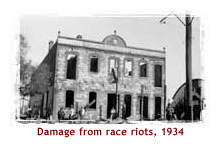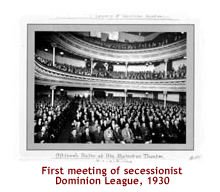|
Discontent 1930s For the people of Western Australia the 1930s was a time of discontent and hardship. Like the rest of Australia and a good proportion of the world, the State experienced economic depression, unemployment, racial violence and disaffection with the ruling political system.  In other parts of the world the Depression triggered radical and sometimes violent political movements offering extreme solutions to the misery caused by unemployment and hunger. Yet in Western Australia the Communist Party remained a relatively small and unsuccessful organisation, efficiently monitored and suppressed by local police, and it was not until 1935 that a Western Australian Nazi party briefly sprung up with just a handful of members. In other parts of the world the Depression triggered radical and sometimes violent political movements offering extreme solutions to the misery caused by unemployment and hunger. Yet in Western Australia the Communist Party remained a relatively small and unsuccessful organisation, efficiently monitored and suppressed by local police, and it was not until 1935 that a Western Australian Nazi party briefly sprung up with just a handful of members.Western Australian business, political and community leaders had long-standing complaints about the treatment of Western Australia since joining the Federation. In a time of economic crisis they were able to attract public support for a movement to secede from the Commonwealth of Australia. It is interesting to note that the first meeting called by the secessionists in 1930 attracted thousands of discontented citizens at a time when the worst of the Depression had yet to hit Western Australia. 
Throughout the early 1930s the frustration and resentment of ordinary people who felt powerless to control their own destiny was directed at Canberra and the East. By the time the secession referendum was held in 1933 the electorate was confused and dissatisfied. They gave expression to their general sense of discontent by voting to secede by a margin of three to one while paradoxically on the same day rejecting the pro-secession government of Premier James Mitchell. Philip Collier's Labor Party was swept back into office even though it opposed secession. |
Please note: The content on this website is made available for archival purposes and may not meet the State Library of Western Australia's current standards for web accessibility, mobile device compatibility, historical accuracy and cultural sensitivity.